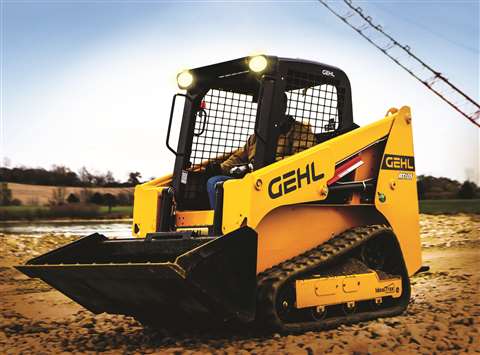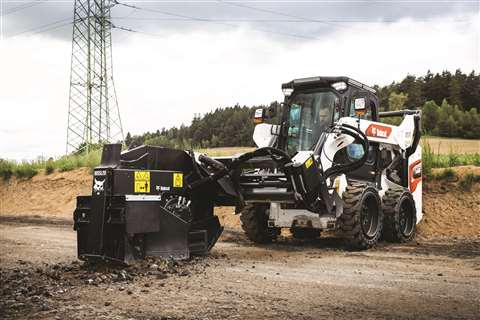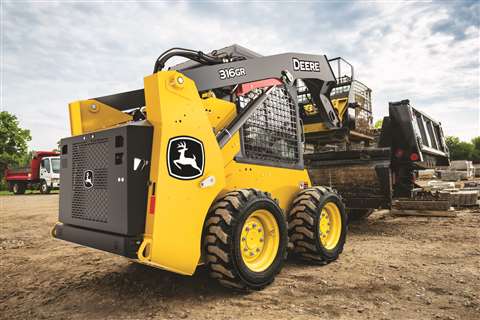Technological advances in skid steers
17 August 2022
Skid steers have long been popular in North America and, while the compact tracked loader gains popularity, there is still a place in construction for the skills of skid steers.
The skid steer loader is well-known for being an all-American product, so it is no surprise that North America is the largest market for this machine segment. It was in the mid-2000s that a high point was reached, with global sales touching 100,000 machines per year, according to industry experts Off-Highway Research.
 GEHL RT 105. (Photo: Manitou)
GEHL RT 105. (Photo: Manitou)
Compact tracked loaders, where the skid steers’ wheels are replaced with a rubber or steel track, first made an appearance during the 1980s. The compact tracked loader is estimated to be around 30% more expensive than a skid steer loader of the same capacity but, despite this, is rising in popularity.
Compact tracked loaders are more expensive, but the tracked undercarriage means they exert less pressure, so can be used in worse ground conditions, or in situations where damaging the ground would be a problem.
What are the operating costs of skid steers?
Despite this, there is still room for the skid steer for projects involving paved surfaces and hard ground – in addition to the lower running costs. Ground space is becoming a premium as cities become more populated and demand for new infrastructure after Covid-19 continues.
Many companies have used this time to redevelop concepts and ensure they are bringing the most innovative products to the industry.
The manufacturer Bobcat has launched the company’s new R-Series Stage V S66 and S76 skid-steer loaders, which the company says is their most significant redesign of Bobcat loaders in 60 years.
To ensure optimum performance and comfort Bobcat says that the stability of the loader has been further improved with longer wheelbases and track footprints compared to the previous generation machines. The higher stability, combined with enhanced efficiency from the hydraulics, provides push and breakout forces and increased lift capacity, resulting in higher productivity.
 Bobcat S66 skid steer loader. (Photo: Bobcat)
Bobcat S66 skid steer loader. (Photo: Bobcat)
Based on low-effort joysticks, the SJC system provides the operator with Bobcat-exclusive features and fingertip switches. This automatically configures the loaders as tool carriers for working all day with the widest possible selection of Bobcat attachments, as well as providing increased operator comfort.
Telematic systems for skid steers
John Deere is one of many US manufacturers at the forefront of skid steer development. To compete in the current market skid steers need to bring increased agility.
Luke Gribble, solutions marketing manager at John Deere sees a migration towards telematics in the industry. “John Deere currently offers JDLink telematics as an optional solution on all of our skid steer loaders,” he says. “Offering telematics solutions on our skid steer loader line-up provides value to our customers and their bottom lines.”
Gribble adds, “Support through the JDLink telematics system provides information on system utilisation and allows rapid diagnosis of problems to reduce downtime on the job. A feature that is becoming more popular on the John Deere large frame skids steers is the industry-exclusive onboard grade indication system.”
The onboard grade indication system provides cross-slope (roll) and main fall slope (pitch) of the machine within the in-cab monitor display. Gribble says, “These are viewable as either degrees or percentages and allow real-time grade checks from the cab of the machine which reduces the need for an individual outside the cab to check grade. This is a fully integrated solution meaning that no additional hardware or software is required.”
Nathan Ryan, global product manager at Manitou Group, agrees that demand for technology is on the up. “An advancement we see in the industry is the use of telematics, such as our Connected Machine solution by GEHL. This program allows contractors or owners to locate their machines, troubleshoot problems, check hours of use and so much more.
“Machines are expensive assets and telematics gives the owners the capability to view the health of the machine from their phone.”
Electric compact construction equipment
Electric equipment is making strides in the compact equipment department and is one many manufacturers are exploring. Deere’s Gribble says that the OEM is “constantly exploring new machine and technology solutions that will help expand our offerings to meet the growing needs of all customers.
The development of a new machine is a multi-year, multi-phase process, and we continue to listen to our customers to seek new ways to meet the demand for expanded hybrid offerings and all-electric equipment.”
 John Deere is looking at electrification by 2026. (Photo: John Deere)
John Deere is looking at electrification by 2026. (Photo: John Deere)
He adds that the OEM has a goal of introducing over 20 electric machines by 2026, a target that they are being helped to meet by strategic integration with companies such as Kreisel Electric.
Automation is an ever-growing trend in this market and could be the key to making machines more efficient and easier to use for operators of any skill level.
“As a direct response to customer demand,” says Gribble, “We developed the EH Boom Performance Package, available on our skid-steer loader line-up. Our productivity-boosting EH Boom Performance Package automates repetitive tasks, improving job site efficiency and safety.
“This package provides several features to help trim cycle times, speed production and improve job site awareness by automating repetitive functions. By offering customisable boom and bucket settings such as return to dig, return to carry, and boom height kick-out, operators can get back to work seamlessly without needing to manually adjust their equipment.”
Ryan at Manitou believes that all OEMs have been focusing on human-machine interface and operator cab refinements for the last few years. “They have been doing this for a few reasons with the main idea centred around operator retention,” he comments.
Autonomy and technology in equipment
Labour shortages across the construction industry mean the demand for autonomy is steadily growing as companies realise the potential of technology. Ryan adds, “It is a major priority for contractors to keep their workers and have equipment that is easy for operators to intuitively understand.
“A better cab design also improves equipment resale value, as equipment owners are expecting their machines to be as nice as their trucks in terms of comfort and electronics. Another area of focus for the past few years has been telematics for better fleet management, proactive maintenance, and a logistics standpoint.”
GEHL’s latest models, RT 105 and RT 135, are smaller units that offer a lot of versatility, says Ryan. These machines have a smaller footprint to easily get through gates and into backyards for landscape applications. Additionally, their lower weight means lower ground pressure and less disturbance to yards, which means less yard repair to the contractor.
Manufacturers are ensuring that their product offerings are in line with the demands of the current market. Compact equipment needs to remain powerful but maintain flexibility for smaller workspaces and, evidently, companies are working hard to find new ways of creating extra efficiency.
STAY CONNECTED




Receive the information you need when you need it through our world-leading magazines, newsletters and daily briefings.
POWER SOURCING GUIDE
The trusted reference and buyer’s guide for 83 years
The original “desktop search engine,” guiding nearly 10,000 users in more than 90 countries it is the primary reference for specifications and details on all the components that go into engine systems.
Visit Now
CONNECT WITH THE TEAM









